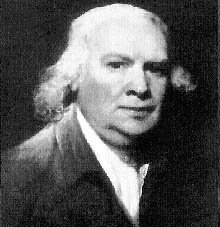Sept. 9 and 10 meetings showed progress toward acceptance of Morris's offer, provided
the reservations' size was adequate. Sept. 12 and 15 passed in consideration of
the reservations.
Cornplanter asked for a large and detailed map prepared
by Joseph Ellicott, the surveyor hired by the Dutch bankers. The original demand
for the Buffalo Creek reservation alone, made by Red Jacket, was one million acres.
During these days, Thomas Morris and Ellicott negotiated the chiefs' various
reservation demands down into specific metes and bounds to reduce future disagreement.
When the final map was ready, 52 representative chiefs, including Red Jacket,
signed the treaty or deed of conveyance. It was agreed that the $100,000 was to
be invested in U.S. bank stock, paying dividends of $6,250 a year, to be delivered
to the Senecas at Canandaigua by the superintendent of Indian Affairs.
At the last minute, Farmer's Brother brought his cousin's white wife, Mary Jemison,
to young Morris, asking him to protect her “corn patch” on the Gardeau
Flats. Morris wanted to oblige the helpful Farmer's Brother and to delay no longer,
but the description Mary gave was vague and designated by natural boundaries.
When it was later surveyed after the conveyance to Mary, Morris found to his chagrin
that the expected 150 acres had expanded to about 18,000 acres!
A claim
by Ebenezer Allen's Seneca daughter (See “Indian Allen, frontiersman, ladies'
man,” Spring '96) was rejected out of hand at the same time.
Ultimately,
the lands transferred from the Senecas to the whites excluded 337 square miles—10
Indian reservations—much more than Morris had hoped to give. Unfortunately,
most of this reservation land did not stay long in Seneca hands. Greedy white
land speculators quickly started bribing and intoxicating Seneca chiefs to get
them to set their fingerprints on deeds, thereby releasing their reservations
for development.
Today, only three reservations remain of the original
10, some of those much diminished in size. Many of these later transactions were
disgraceful.
Some say the Treaty of Big Tree itself was a disgrace. This
is less clear. A few chiefs (including Red Jacket himself) apparently received
bribes or offers of annuities after the premature covering of the council fire.
Such payments were not unusual at treaties with Indians, and there is a fine line
between a gift and a bribe.
The Indians expected gifts as part of the process,
particularly if the donees were influential speakers. Today's standards are rarely
the same as yesterdays.
It took two years for Joseph Ellicott to survey
the lands and prepare them for sale. The settlers were not far behind, and many
were New England farmers introduced to western New York by Gen. Sullivan's expedition.
One way or another they would have come, but the Treaty of Big Tree meant they
came in peace.
Robert Morris
The financier finally floundered
 Robert
Morris of Philadelphia, the “financier of the American Revolution” saw
his financial house crumble after speculating too heavily in western lands.
Robert
Morris of Philadelphia, the “financier of the American Revolution” saw
his financial house crumble after speculating too heavily in western lands.
Morris
was born in England in 1734, came to the colonies at age 13, and was an important
member of a Philadelphia shipping and banking firm by age 20.
He was one
of only six men who signed both the Declaration of Independence and the Constitution
of the United States.
Morris raised great amounts of money to support the
Continental Army during the American Revolution and was superintendent of finance
for the young U.S. government from 1781-83.
To help settle the U.S.'s financial
situation, he established the Bank of North America in 1782.
Morris invested
heavily in unsettled lands thoughout the nation, but his credit collapsed in the
1790s and he spent three years in debtor's prison.
Released in 1801, he
spent the last five years of his life in near poverty.

